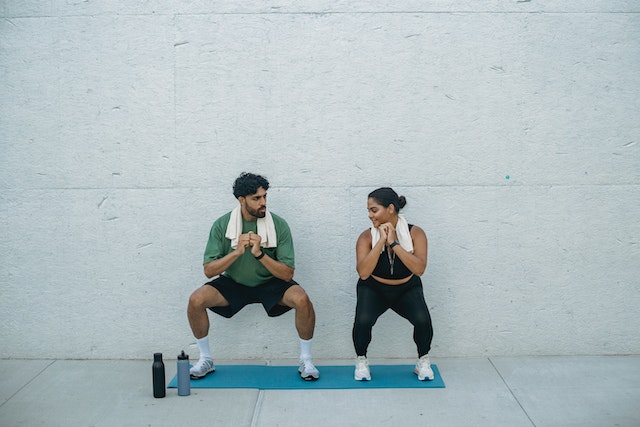Squats, a fundamental exercise in strength training, have become increasingly popular in recent years due to their effectiveness in targeting multiple muscle groups. While many people are familiar with the traditional squat, there is a vast array of squat variations that offer unique benefits and target specific muscles.
In this article, we will dive into the world of squats and explore different types that can enhance your fitness routine and help you achieve your goals.
The Traditional Squat
Let’s start with the foundation – the traditional squat. This exercise primarily targets the glutes, quadriceps, and hamstrings. To perform it, stand with feet shoulder-width apart, lower yourself by bending your knees and then rise back up. By perfecting your form and gradually increasing your weight, you can strengthen your lower body and improve your overall stability.
Goblet Squat
The goblet squat is a variation that involves holding a dumbbell or kettlebell close to your chest, creating a counterbalance. This exercise places more emphasis on the quadriceps and challenges your core stability. Goblet squats are particularly beneficial for beginners, as they help develop proper squatting mechanics while providing an effective lower-body workout.
Sumo Squat
Taking inspiration from sumo wrestlers, the sumo squat involves standing with your feet wider than shoulder-width apart and toes pointed out at an angle. This variation targets the inner thighs and glutes to a greater extent than the traditional squat. The wider stance also allows for increased hip mobility and can benefit individuals with tight hip flexors.
Bulgarian Split Squat
If you’re seeking a unilateral exercise that targets each leg individually, the Bulgarian split squat is an excellent choice. With one leg elevated behind you on a bench or step, lower your body by bending the front knee. This exercise places a significant load on the quadriceps, hamstrings, and glutes while challenging your balance and stability.
Pistol Squat
The pistol squat is an advanced unilateral squat that requires exceptional strength, balance and flexibility. With one leg extended in front of you, lower your body down on the supporting leg while keeping the other leg off the ground. This exercise primarily targets the quadriceps, hamstrings, and glutes while also engaging your core. Mastering the pistol squat showcases both strength and control.
Overhead Squat
The overhead squat is a challenging variation that not only strengthens your lower body but also enhances upper body mobility and stability. With a barbell or a weighted object overhead, squat down while keeping your arms extended. This exercise targets the quadriceps, hamstrings, and glutes while engaging the shoulders, upper back and core. Proper form and mobility are crucial for performing this exercise safely and effectively.
Here are some key advantages of incorporating squats into your workout routine:
Strength Building: Squats are a compound exercise that engages multiple muscle groups simultaneously, including the quadriceps, hamstrings, glutes and core. By consistently performing squats with proper form and gradually increasing the weight, you can develop significant lower body strength and power.
Muscle Growth: Squats are known to be one of the most effective exercises for building muscle mass. The compound nature of the squat activates a large number of muscle fibers, leading to muscle hypertrophy. Increased muscle mass not only enhances your physical appearance but also boosts your metabolism, making it easier to manage weight and burn calories.
Functional Fitness: Squats mimic movements we perform in our daily lives, such as sitting down and standing up. By strengthening the muscles involved in these movements, squats improve your functional fitness and make everyday activities easier and more efficient. Additionally, stronger leg muscles contribute to better balance and stability, reducing the risk of falls and injuries.
Enhanced Athletic Performance: Whether you’re an athlete or a recreational fitness enthusiast, squats can help enhance your performance in various sports and physical activities. The explosive power generated during squats transfers to activities like jumping, sprinting, and lifting, allowing you to create more force and perform at a higher level.
Joint Strength and Stability: Contrary to the myth that squats are bad for your knees, properly executed squats can actually strengthen the muscles around the knees, hips, and ankles. Stronger muscles provide better support to the joints, reducing the risk of injuries and improving overall joint stability. It’s important to maintain proper form and gradually progress with weights to ensure joint health.
Improved Bone Density: Squats, being a weight-bearing exercise, stimulate bone growth and help improve bone density. This is particularly beneficial for individuals at risk of osteoporosis or age-related bone loss. Incorporating squats into your routine can help maintain and strengthen your skeletal system, promoting long-term bone health.
Metabolic Boost: Squats are a demanding exercise that recruits a large number of muscles. This increased muscle activation stimulates the body’s metabolic rate, leading to greater calorie burning and potential fat loss. Squats can be an effective addition to a well-rounded weight loss or body composition program.
Mental Resilience: Performing squats requires focus, mental discipline, and the ability to push through physical challenges. Consistently incorporating squats into your workouts can help develop mental toughness, discipline and resilience, which can carry over into other aspects of your life.
Remember that is essential to start with proper form, progress at your own pace, and consult a fitness professional if you’re new to squats or have any concerns. By reaping the numerous benefits of squats, you can unlock your fitness potential and elevate your overall well-being.
While the traditional squat is undoubtedly effective, incorporating various squat variations into your fitness routine can provide a diverse set of benefits. Whether you’re aiming to build strength, improve stability, or target specific muscle groups, the wide range of squat options ensures that you can customize your workouts according to your goals.
Prioritize proper form, gradually increase weights and consult a fitness professional if you’re unsure about performing any exercise correctly.
Words by Kaba Abdul-Fattaah.








